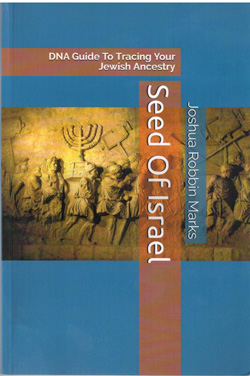Seed of Israel: DNA Guide To Tracing Your Jewish Ancestry by Joshua Robbin Marks, 48 pages including endnotes; available on Amazon.com for $14.99.

 SAN DIEGO – Perhaps your friends or relatives have told you that they did a DNA test and found out about their ancestry, and now you’re wondering whether you should be tested similarly. Journalist Joshua Robbin Marks provides readers in this slim, jargon-filled volume with tips on how to go about it, and what you might expect.
SAN DIEGO – Perhaps your friends or relatives have told you that they did a DNA test and found out about their ancestry, and now you’re wondering whether you should be tested similarly. Journalist Joshua Robbin Marks provides readers in this slim, jargon-filled volume with tips on how to go about it, and what you might expect.
In brief chapter essays, Marks tells about his own experience learning that he is 100 percent Ashkenazi Jewish, explains the basics of DNA – Jewish and otherwise –, and provides a brief summary of where and when contingents of Jews have settled over the centuries.
I was a bit daunted by this paragraph:
According to the website Levite DNA, Ashkenazi Jews display the greatest frequency of E haplogroup (21.89 %) on the Y-DNA side followed by J2 (17.83 %), J1 (17.77 %) R1b (11.50 %), G (9.94 %), R1a (9.29 %), Q (4.56 %), T (2.87 %), I (2.67 %), R2 (1.27%), L (O.27 %) and N (O.12 %).
Nevertheless, I plunged on, and I was glad that I did.
I learned from Marks that approximately 900 years ago, Jews who were descended from those who migrated from Judea to Italy were on the move again. They went to Germany, there becoming the progenitors of the Ashkenazim. This was not a mass movement such as described in the Biblical Exodus. It involved a relatively few families. who, over time, became even fewer.
“Ashkenazi Jews are all around 30th cousins or less because of a genetic bottleneck in the Medieval era of 600 to 800 years go of just 350 people,” Marks informs us.
Perhaps, then, I should say “Cousin Marks informs us.”
If you decide to genetically research your ancestry, Marks recommends that you start with “one of the major commercial DNA testing companies” such as Ancestry, 23 and Me, FamilyTreeDNA, or My Heritage.
After you get your results from one of them, in some cases you may upload those results to one of the other services, thereby compiling even more information about your genealogy and heredity.
My grandson Shor recently had a DNA test and learned, unsurprisingly, that he is 100 percent Jewish. I deduced that if he is 100 percent Jewish, then I must be too. But the routes that my ancestors may have traveled over the centuries – now there is information I’d love to learn.
*
Harrison is editor of San Diego Jewish World. He may be contacted via donald.harrison@sdjewishworld.com
San Diego Jewish World received this message:
In your August 26, 2019 review of Joshua Robbin Marks’ book “Seed of Israel: DNA Guide To Tracing Your Jewish Ancestry” in San Diego Jewish World, you ended with the statement “the routes that my ancestors may have traveled over the centuries – now there is information I’d love to learn.”
For more details on Jewish migrations around Europe than Joshua Marks provides in his short book, you and other people can consult chapter 10 of my book /The Jews of Khazaria, Third Edition/ (Rowman & Littlefield, 2018)
which contains such information-packed sections as:
“The Migration of German Jews into Eastern Europe” on pages 176-178
“The Migration of Czech Jews into Eastern Europe” on pages 175-176
“The Migration of Sephardic Jews into Eastern Europe” on pages 182-184
“The Migration of Mizrakhi (‘Eastern’) Jews into Eastern Europe” on pages 185-186
“Other Early Traces of Jews in Poland” on pages 192-194
“Jews in Lithuania and Belarus” on pages 194-196
with details including:
* earliest attested presence of Ashkenazic Jews in particular cities and towns
* Ashkenazic rabbis and other Ashkenazic personalities
* the development of the Yiddish language from multiple types of German
* the use of West Slavic and East Slavic languages by early Jews
* Slavic and Yiddish first names used by early Ashkenazic Jews
* the histories of noteworthy Jewish surnames that tell us about Jewish migrations
An earlier (Second) edition of my book was reviewed by Sheila Orysiek in San Diego Jewish World on June 14, 2015 in which she wrote “Author Kevin Brook in The Jews of Khazaria … writes an intriguing and masterful history of this once powerful kingdom, how and why it chose to convert to Judaism and its resultant history.” (because chapters 1-9 are about the Khazars)
Also, contrary to Joshua Marks’ assertions, Ashkenazim are not “100 percent” solely descended from the Jewish migrants from Israel to Italy to Germany. There were some genetic inputs between the 800s and the 1600s from German, French, Polish converts to Judaism as reflected in maternal haplogroups like H7j, H7e, J1c7a, K2a2a, and H11a2a2 and autosomal DNA signals of ancestry from northern and eastern Europe that show up in deep ancestry tools like Eurogenes K36, DNA Tribes, nMonte, and EthnoGene. European genetic input is also why a Northern European variety of the red hair gene R160W, a French mutation of Tay-Sachs Disease, a Polish mutation causing breast cancer, and an ancient Russian mutation in CCR5-Delta32 that protects against HIV and bubonic plague are found among Ashkenazim.
Kevin Alan Brook